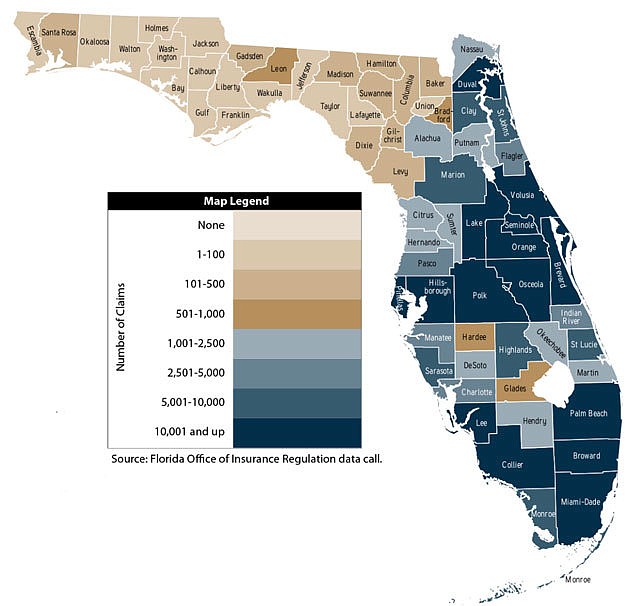- November 22, 2024
-
-
Loading

Loading

When Longboat Key insurance broker Michael Mailliard woke up Monday, Sept. 11, he had a feeling it was going to be a long, bad day. Especially for his clients in Naples. “I thought for sure their houses would be goners,” he said.
As it turned out, Irma had inflicted little to no damage on them.
“The building codes worked!” Mailliard exclaimed.
After Hurricane Andrew in 1992, the Legislature adopted among the most stringent, anti-storm building codes in the nation. And as Irma headed toward the Keys and South Florida, many lawmakers, insurers, window makers and homebuilders familiar with the codes said Irma would be the test.
At this stage of post-Irma, it looks as though the codes did what was intended (see the excerpt below from the Sept. 14 Miami Herald). Property damage totals are not complete, but the estimates are between $25 billion to$35 billion in five states. As of last week, roughly 405,000 claims had been filed in Florida, with damage estimates of
$3 billion. Nowhere near the calamity we all envisioned.
Luck, for sure. But also that damage claims are not worse can be attributed to Florida’s building codes.
You can bet, then, that when Florida Speaker Richard Corcoran convenes 21 House members to review what worked and what didn’t with Hurricane Irma, one of many recommendations to surface will be mandates to require the stricter codes in older structures — especially along the coasts and the most flood-prone areas.
Indeed, perhaps the prediction of an Observer colleague is right: We are likely to look back on Irma as a turning point in how Florida and its citizens live with hurricanes. After seeing the destruction in Puerto Rico, Florida lawmakers, homebuilders, commercial contractors and insurers — as well as Florida’s citizenry at large — will debate the following tradeoff: We can either:
Take it from the Dutch, whose public policies focus on disaster avoidance: “We know that if things go wrong, we pay for decades,” Wim Kuijken, the Netherlands’ senior official for water policy told the New York Times.
Sure, lives are always at risk and are of primary concern. But the costs of post-hurricane reconstruction go far beyond the costs of rebuilding destroyed homes, apartments, stores and offices. While rebuilding may provide an economic boon to all those businesses associated with building, repairing and furnishing homes and apartments, reconstruction is not an economic plus. It’s not economic growth. All that money that goes into rebuilding is money that would have been used for other productive means that would have expanded the economy beyond where it was before the storm.
It’s French writer/economist Frederic Bastiat’s broken windows metaphor. When a scoundrel throws a rock through a shopkeeper’s window, the shopkeeper must spend what he saved to replace the window instead of buying a new suit or new shoes. The window maker benefits, but the suit and shoe makers lose.
If Florida’s buildings, power lines and water and sewer systems were constructed to withstand 150 mph winds and storm surges, think of the time and human and monetary capital saved for economic growth instead of rebuilding ourselves out of misery.
The disaster avoidance approach would make Florida a much more expensive place to live. But that’s the tradeoff for paradise. Paradise will always be more expensive and pleasant than living in post-hurricane hell.
When the electricity runs uninterrupted, no one thanks the power company. We take our electricity for granted.
But when the power goes out, the grumbling begins. Surely you’ve heard comments that because of its government-sanctioned monopoly-like status, Florida Power & Light Co. should be scrutinized for the extent of the loss of power after Irma. Ninety percent of FPL’s 5.1 million customers (10 million Floridians) in 36 Florida counties lost power — the most in FPL history.
Now it’s easy to jump to conclusions — such as FPL’s power grid must be below standards. But when you know some of the facts, an impressive picture emerges:
Over the past decade, FPL has invested more than $3 billion to make its grid more storm resistant. According to the company, no hardened transmission structures were lost. All of FPL’s substations were running within a day after Irma. “In fact,” the company said, “FPL lost only a fraction of its poles, which today number 1.2 million, as compared with (Hurricane) Wilma — with early estimates of approximately 2,500 downed (0.2%) during Irma as compared with roughly 12,000 during Wilma.”
What’s more, FPL reported that before Irma left FPL’s territory the company had restored power to 1 million customers and had 2 million running again by the end of the first day of restoration.
To restore power, the company assembled the largest restoration workforce in U.S. history, more than 28,000 workers from 30 states and Canada working 24/7.
Eric Silagy, CEO of FPL, said the company “completed the fastest restoration of the largest amount of people by any one utility in U.S. history.”